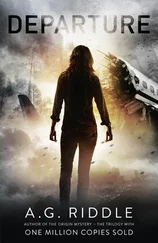“Are they reversing?” I ask.
Colonel Campbell shakes his head without taking his eyes off the plot. “No. They’re running.”
He magnifies the relevant section of the display and spins it to orient the tactical symbols in a plane I can see.
“They’ve accelerated. I’m guessing by the rate they’re going for maximum burn. And they’re headed ninety degrees away from our incoming party guests. Into deep space.”
“They’re running,” I repeat. I want to get angry at the fact that the task force commander has chosen to make discretion the better part of valor instead of returning to us to defend the only NAC settlement in the system from almost certain annihilation, but part of me can’t fault him. Part of me would rather be on the Midway right now. They may just be the last humans alive in the Fomalhaut system once we’ve all played our hands.
“Smart,” Colonel Campbell echoes my thoughts. “Not brave, but sensible.”
“Bogey will intercept the cruiser in fifteen minutes,” the tactical officer announces. I notice that he doesn’t refer to the SRA ship as a bogey as well. I watch the red icon on its futile, limping run away from the monster that’s chasing it. A week or a month ago I would have cheered the prospect of blotting a Russian space control cruiser from the plot, but now my stomach clenches at the thought of the poor bastards who have fifteen minutes of existence left before the Lanky overtakes them and shotguns their ship from bow to stern with yard-thick spikes that will crack open every pressurized compartment they have left.
We keep watching the plot as the minutes tick down on the CIC’s clock. It’s like watching a condemned prisoner squirming on the gurney as the executioner approaches. The distance between the icons decreases until they look like they’re on top of each other even at maximum display magnification.
“Two hundred and fifty thousand,” the tactical officer calls out. “Two hundred…one-fifty…one hundred…”
He brings up the video feed from the central optical array and superimposes it on the tactical plot. The Russian cruiser is a little gray dot in the middle of the segment. I don’t see the Lanky at all.
“Fifty. Twenty-five. They should be overtaking them right…about… now .”
I still don’t see the Lanky ship on the screen, but suddenly there’s a bright flash of light, searing and white-hot even at this distance and magnification. Then the Russian cruiser is an expanding ball of fire that rapidly scatters and disperses into the blackness of space.
“What the hell was that ?” the tactical officer asks.
“Nuclear detonation,” I say. That wasn’t a fusion bottle letting go after battle damage, but a high-yield atomic warhead going off in hard vacuum.
“Son of a bitch,” Colonel Campbell says, with something akin to respect in his voice. “They launched their nukes at contact range.”
“Did they kill the Lanky?” Dr. Stewart asks. She looks nauseated.
“Not likely,” Colonel Campbell says even before the tactical officer checks the optical feed to answer her question. “That wasn’t their goal anyway, just a possible fringe benefit.”
“They went out on their own terms,” I say. “Launched the nukes to kill themselves and possibly the Lanky, too.”
“That is insane ,” Dr. Stewart says.
“You’ve never seen a ship that was hit by a Lanky broadside,” I reply. “People getting sheared in half by a Lanky penetrator. Running out of air. Those are some shitty ways to die. Nuclear fireball? Instant oblivion.”
“And a last ‘fuck you’ to the other team,” Colonel Campbell says.
“I have the Lanky back on optics,” the tactical officer says. “He’s backlit from the nuke right now. Same speed and heading. Didn’t even slow down for the intercept.”
“Or from getting twenty megatons right in the kisser,” Colonel Campbell says. “Keep tracking him until you lose him, and then have the computer track his trajectory with the optical array, same speed. He’ll turn invisible on us again sooner or later. Let’s make sure we can find him again.”
“Well, there we have it,” I say to the CIC in general. Then I send a transmission down to New Longyearbyen.
“Fallon, Grayson. The Lanky has overtaken the Russian. He’s coming our way now, same trajectory.” I don’t have to mention that the SRA cruiser is now a cloud of debris vapor still traveling at one-quarter-g acceleration.
“Copy that,” Sergeant Fallon sends back. “It’s all on you now. Doorknocker commences in sixty minutes. Keep me posted. Fallon out.”
There are no windows in the CIC—the combat information center is always deep in the center of a warship, where it’s most protected—but I can tap into the numerous optical sensors on the outside of the hull. Below us, New Svalbard is a cold, white ball of frozen ground and ice, barely more hospitable than the rest of this system. Fomalhaut c looks ethereal in its almost translucent presence, blue storm swirls the size of entire Earth continents rippling on its surface. Somewhere in the black void beyond, toward the Fomalhaut star that is twinkling brightly in the distance, there’s a Lanky seed ship coming for us, and all the plans we’re making right now feel a little bit like the battle strategies of cockroaches who see the boot coming down on them.
Still, we gear up to throw our rocks and give them the finger because that’s what we do. The Russian cruiser captain, or whoever had survived to remain in command over there, did exactly that when the boot came down on him, and if our water-laden kinetic missile fails to hit the target, I hope to go out in a similar way. Not that anybody would ever know.
We spend the last hour before the launch double- and triple-checking all the numbers, and then starting over and checking them again from scratch. Dr. Stewart has gotten the same response from the computer every time, and she still verifies everything by hand and with her data pad. The Neural Networks guy on the Indy is a sergeant who looks to be about my age. He graduated Neural Networks School the same year I did, two classes before me, and it occurs to me that he is exactly where I would be at this point in my career if I hadn’t opted to go for the combat-controller track because I got bored watching progress bars all day long. In an alternate universe, I may be the one sitting in the Networks Center of the Indianapolis right now, with some other combat controller looking over my shoulder. Maybe in yet another alternate universe, we’re still in the task force that’s running away, or we’re part of the debris cloud that’s now dispersed behind the approaching Lanky.
I watch as the Indy ’s Networks administrator systematically disables all the fail-safes and security protocols on the Gordon ’s shipboard network. I went to Networks School and had his job for over a year in the fleet, so I know that some of the things he’s doing are supposed to be impossible to do, and very definitely in violation of fleet regulations. It’s also how I know that he is good at his job and not just one of the bottom 10 percent of his tech school class.
“I’m probably the first Neural guy in the fleet who has ever gotten to do this in real life,” he says as he digs his way through yet another subsystem of the Gordon ’s central computer. “Pissing on every safety reg in the book.”
“They’ll bust you back to private and drum you out without your end-of-service bonus,” I say, and he grins.
“ Please ,” he says.
Without the crew on board and with all her hollow spaces filled with water, the Gordon will be able to pull much more sustained acceleration, and the reactor won’t need to spend any of its energy budget keeping the artificial-gravity deck plates energized. What we’re about to do has never been done, not even with a target ship, and it’s only even possible because the Gordon has military-grade propulsion and computer systems, to keep up and interface with the fleet units she was built to support. Still, nobody has ever thought of pushing a military freighter to four gravities of sustained acceleration and keeping her there for thirty-five hours. We are truly on the cutting edge of desperate measures.
Читать дальше












